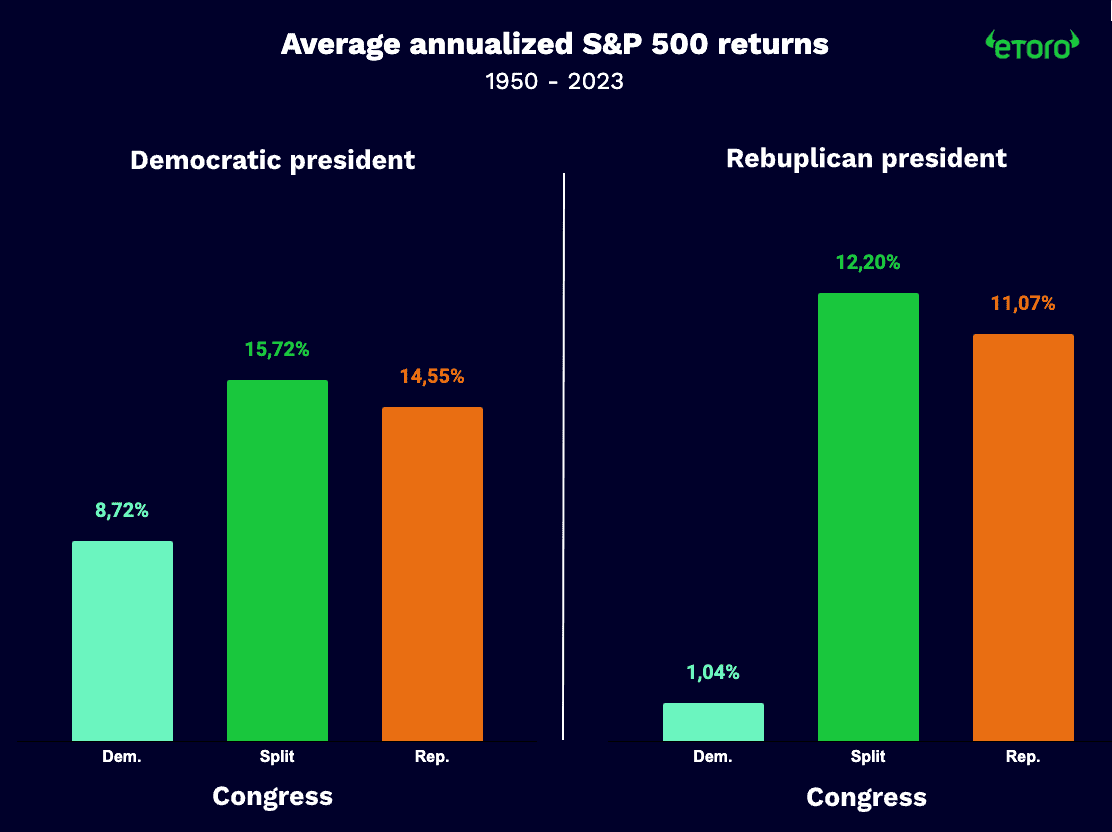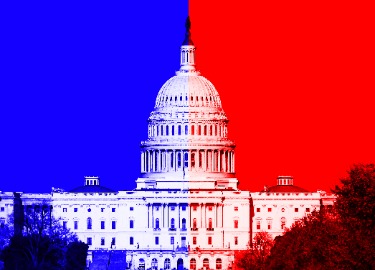- Data shows that markets rise regardless of who sits in the Oval Office, but a divided Congress has been best for equities performance (YCharts)
- Trump plans to lower corporate tax by 6%, while Harris wants to hike it by 7%
- National debt is expected to increase under both candidates, says CRFB (Committee for a Responsible Federal Budget)
With the 47th U.S. presidential election just hours away, the tight race between Democratic Vice President Kamala Harris and Republican former President Donald Trump is driving volatility and uncertainty. Just seven states may decide the result. In the final hours leading to the election, markets are volatile as investors try to position themselves for potential outcomes.
However, the presidential election is just part of the story. The House of Representatives and ~⅓ of the Senate are also being elected today. The outcome can heavily affect how easily policies are implemented. Polls suggest that Republicans may secure the Senate, while Democrats could gain control of the House. However, a red sweep is also in the cards.

Historical market returns in different scenarios. (source: YCharts) *past performance is not an indication of future results.
How might each candidate’s victory impact the stock market? We’ve dug into the details to give you a clear perspective:
Taxes
The obvious impactful difference is the candidates’ stances on corporate taxes. Both are within their parties’ rhetoric: lower taxes in the case of Trump and higher taxation with Harris.
Here’s a breakdown:
Trump TAX – Trump proposes to lower the corporate tax rate from 21% to 15% for companies producing within the U.S. He also plans to reinstate tax write-offs for investments in equipment and research.
Harris TAX – Harris proposes increasing the corporate tax from 21% to 28%. She also wants to raise long-term capital gains taxes to 28% from the current 20% for individuals earning over $1 million. Additionally, she suggested increasing stock buyback taxes to 4% from the current 1%.
That said, Harris also proposed a new tax credit for U.S. manufacturers in sectors such as steel, biotech, AI, semiconductors, aerospace, automotive, and agriculture.
Tariffs
While it may be unusual, tariffs are a prominent topic in this election because Trump wants to use them to replace revenue from significant tax cuts. Much of his policy relies on massive tariffs on most imported goods. Meanwhile, Harris opposes Trump’s plans and has no further tariffs on her agenda.
Trump tariffs – Trump plans to impose up to a 20% tariff on all imports to boost domestic manufacturing. He took a decisive stance against China, proposing tariffs of >60% on all Chinese imports and revoking China’s permanent trade status. Trump also aims to limit Chinese acquisitions of U.S. industries and strengthen ties with Taiwan.
Harris tariffs – Harris has openly criticized Trump’s tariffs as a “sales tax” on Americans. However, while she hasn’t announced any tariffs, the Biden administration has retained most of Trump’s former ones and even increased some of them, notably on Chinese EVs. According to a Bloomberg report from October 2024,, the Biden administration discussed the possibility of capping sales of advanced, US-made AI chips to select countries.
Regulation
Republicans generally oppose regulation, and this time, it’s no different. In contrast, the Biden administration has kept regulatory oversight especially tight.
Trump regulation – Trump advocates for significant deregulation and will likely push for looser regulatory oversight.
Harris regulation – Harris would likely maintain the status quo, continuing the Biden administration’s policies of close oversight and tight conditions.
According to Fitch Ratings, under the Biden administration, regulators have taken “markedly” longer to approve bank mergers, sometimes “to the point of making deals non-viable, as market conditions turned during the review period.”
Climate change (CC)

(source: Shutterstock)
Lastly, the candidates’ differing views on climate change might cause significant shifts in the energy industry.
Trump CC – Trump is skeptical of climate change initiatives, questioning their necessity and impact. He intends to withdraw the U.S. from the Paris Agreement, reversing commitments to global emission targets. Additionally, Trump plans to boost domestic oil and gas production. He also seeks to cancel EV subsidies and clean energy tax credits.
Harris CC – Harris supports clean energy initiatives and the transition to EVs, aiming to reduce emissions and promote green energy. She cast the tie-breaking vote to pass the Inflation Reduction Act, allocating hundreds of billions for electric vehicles (EVs) and clean energy projects. Support for clean energy is expected to remain solid if she wins.
What could a divided Congress mean for markets?

(source: Shutterstock)
Historically, equities have performed well under a divided Congress. This trend is attributed mainly to congressional gridlock, which reduces the likelihood of significant policy shifts disrupting markets. In the current context, a divided Congress could lessen the risk of significant tax increases under a Harris administration or unexpected foreign policy moves by Trump, for example.
This would offer markets a more stable, predictable environment. While checks and balances are generally beneficial, cooperation between parties is also essential to resolve economic challenges.
Which industries will be affected?
Energy
Trump’s plan to boost domestic drilling may benefit the oil industry and provide a tailwind for fossil fuels. However, his approach could harm renewables, as Trump has promised to repeal the Inflation Reduction Act, putting over $200 billion of green energy investments at risk.
On the other hand, Harris has signaled her intention to continue supporting renewables such as wind and solar, which have historically done well under democratic leadership.
Manufacturing
The U.S. automotive industry faces headwinds such as intense Chinese competition, high inventories, and slowing growth.
Under Harris, business should continue as usual, with an added boost for US-made EVs through tax credits outlined in the Inflation Reduction Act (IRA). Domestic auto producers should benefit from Harris’ tax credits as well, in addition to IRA benefits, as the law specifies that EVs must meet specific criteria for sourcing materials and parts domestically.
A Trump presidency could shuffle the cards, as his tariffs on Chinese imports and lower EV tax credits should shift the automotive landscape, possibly benefiting domestic carmakers who fell behind in the EV race, simultaneously making them more competitive against those that rely on imported parts from overseas.
Beyond cars, Trump’s proposed tariffs would likely impact broader manufacturing too. Domestic producers might benefit from reduced competition but could face pricier imports. Additionally, retaliatory tariffs from other countries could hurt U.S. manufacturers’ sales abroad.
Defense
Both candidates should maintain military spending. However, their differing foreign policy approaches could influence specific defense markets.
Harris is expected to uphold U.S. commitments to European allies and Ukraine, which would sustain demand for equipment and ammunition supplied to allies.
Alternatively, Trump plans to boost military spending but intends to significantly reduce U.S. support for European allies and Ukraine, potentially hurting demand for related products.
Ballooning debt
Amid all the uncertainty, one thing is clear: both candidates’ plans would substantially increase the national debt. According to the Committee for a Responsible Federal Budget, Harris’s plan would add nearly $4 trillion to the national debt over the next decade, while Trump’s policies could raise it by as much as $7.8 trillion.
Conclusion
Looking at both candidates’ policy platforms, it’s clear that each has a number of proposals to stimulate certain sectors while restraining others. Their ability to implement these proposals depends on the results of the congressional elections. Ultimately, the fundamentals of the US economy remain strong – with market-leading companies operating in most sectors. Whichever candidate is victorious, the US economy is predicted to grow by 2.2% in 2025, according to the IMF’s World Economic Outlook.



